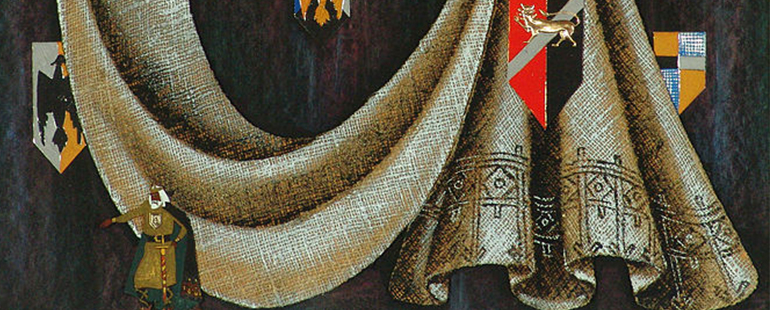Watching King Lear on Zoom

In Act III, Scene II of King Lear, an aging Lear discovers that his two older daughters have betrayed him, and with his Fool he’s cast out onto a storm-lashed heath, left to howl and rage at his own suffering. In typical productions, Act III, Scene II might begin with flashes of lightning as the king huddles with his court jester for warmth and comfort, but in Richfield, Ohio’s Western Reserve Playhouse’s recent online reading of the play, we see instead what amounts to a talking head “stuck in this little computer box,” says actor and director August James Scarpelli, “wrestling with [Shakespeare’s] dexterous and penetrating language and a narrative of cosmological significance.” The incongruity between form and content Scarpelli describes is surprisingly timely. Zoom, he says, exacerbates “our own personal and intimate feelings of loneliness, interruption, and miscommunication.” He’s right: in recent months, most of our interactions have been relegated to the internet, forced into a technology we often find touchy and incongruous, at times throwing us out of synch with ourselves and each other.
Language is a technology too, and not without its own erratic, dissociating quirks. If King Lear is (among other things) about miscommunication—those moments when language fails, the delay or gap that occurs between utterance and transmission, between transmission and comprehension, between object and its symbolic representation—then the play takes on a new immediacy in the context of a 2020 Zoom call. While Scarpelli suggests comedies like Shakespeare’s Much Ado About Nothing (presented by Western Reserve Playhouse via Zoom in May) offer more overtly playful opportunities to interact with the technology, King Lear proves challenging. Mitch Rose, who plays the Fool in Scarpelli’s production, tells me he was concerned at first. He’s “not a technology-forward person and am continually skeptical of its value as good communication, but Shakespeare exists in a much deeper expressive world than emojis and scrolling,” he says. “But once you can hear and see another actor, you can begin to create some kind of resonance within yourself.” Lear’s attempt to find “a resonance” that transcends cultural norms and hierarchical structures is thwarted again and again by confusion and misapprehensions. In the context of a Zoom call, Lear is made to see his own dissembling and dissolution on-screen and, perhaps most importantly, he sees others seeing it. He bears witness to communication’s breakdown, the failure of language to operate efficiently and effectively.
While “Zoom fatigue” isn’t Shakespearian “madness,” it does suggest we’re reacting physically to a situation that feels, as Shakespeare might say, “unnatural.” Many of us, as psychologist Marissa Shuffler suggests, feel exhausted by attempting to manage the blips and gaps in virtual interactions; verbal nuances are lost and body language is hard to read. “Zoom fatigue,” however, is a term that could apply more broadly to our online personae—creating and maintaining them. Discussions around technology’s alienating, fracturing effects aren’t new, but they have, arguably, taken on a real urgency as a result of the COVID-19 pandemic. Too, pandemic-inspired life and cultural changes aren’t new either. In fact, critic Andrew Dickson, in his Guardian article “Shakespeare in lockdown: did he write King Lear in plague quarantine?” argues that it’s possible King Lear was written in 1606 when mass gatherings were banned and London’s theaters went dark due to yet another outbreak of the bubonic plague. We might imagine a population isolated by fear, misinformed, and confused. We might imagine relationships strained by anxiety and grief. We might imagine King Lear forced inside a virtual box, headphones on, his words garbled as he asks his daughters, “Tell me . . . which of you shall we say doth love us most, / That we our largest bounty may extend / Where nature doth with merit challenge.”
King Lear begins with that life-altering misapprehension. Lear, in his dotage, decides to retire from his duties, and divide his kingdom between his three daughters. But first, he wants them to tell him how much they love him. Believing he can ascertain his daughter’s “natures” through language, Lear misunderstands the very “nature” of language—that is, he wrongly believes in a direct, universal correlation between intention and utterance. His third daughter, Cordelia, though she’s the youngest, understands more fully language’s potential for confusion, even deception. She refuses to say she loves her father more than her sisters because to do so would mean disloyalty to herself as well as to her father. Cordelia acknowledges her sisters’ verbal irony, but Lear misunderstands, rebukes, and ultimately disinherits her. She tells her father, “Unhappy that I am, I cannot heave / My heart into my mouth,” though Regan and Goneril (his two older daughters) are keen to blanket Lear in praise. As a result, they create, for their father’s benefit, “on-stage” personas that exist in contrast to their “real selves,” and Lear is taken in by their performance.
Social interactions on the internet generally (and video conferencing specifically) have a tendency toward the performative. They often result in a fracturing of the self; on camera, one is simultaneously aware of one’s visual presentation and how it may or may not correspond to what scientist Susan Greenfield in her book Mind Change calls “the real self,” which, Greenfield says, “entails the carefully constructed and unique mind interacting with a large number of momentary external contexts over time.” In contrast, she goes on, “like a funhouse mirror, the online self is likely to be an exaggerated version of the real self. And this exaggeration could get out of hand . . . this online self is an invention that, for most people, is a continual approximation of presenting our sense of self to the world.” She says, “a dangerous gap could grow between this idealized ‘front stage’ you and the real ‘backstage you,’ leading to a feeling of disconnection and isolation.” Goneril and Regan, in playing the part of King Lear’s villains, over the course of the play become yet more “villainous,” reaching new heights of savagery, as if they’ve breached the gap between one persona and another, becoming, in the end, utterly debauched, the “funhouse,” “exaggerated versions of [their] real [selves.]”
If Goneril’s and Regan’s fracture leads to adultery and murder, then other characters’ responses to their own fractured identities are to throw off the external markers of “sanity,” “cleanliness,” and “civilization” in pursuit of a kind of manic prophecy. Renaissance scholar Gillian Woods describes Edgar, for example, as “a still more radically disordered role, and a fractured mirror for Lear himself.” Edgar—who has been wrongly framed by his half-brother for their father’s attempted murder—bares himself to the elements, smears himself with mud, and cuts his skin with a hawthorn branch. In an attempt to eradicate his former self, he transforms into Poor Tom, a persona, Woods says, influenced by the “‘Abraham Men’ who pretended to have come from Bethlem Hospital near Bishopsgate in London, an institution for the mad.” And Edgar has fully embraced his new self. When asked by his own father who he is, Edgar replies,
Poor Tom, that eats the swimming frog, the toad, the tadpole, the wall-newt and the water—; that in the fury of his heart, when the foul fiend rages, eats cow-dung for salads; swallows the old rat and the ditch-dog; who is whipped from tithing to tithing and stocked, punished and imprisoned—who hath had three suits to his back, six shirts to his body . . .
In other words, Edgar (now Poor Tom), operates outside propriety, devouring animals “civilized” society would deep inappropriate, and is “lowly,” or “dirty.” His alternate persona is further complicated by claims of demonic possession—a dissociative tactic meant to allow for subversive, taboo-breaking, disordered language. Yet, Edgar (as Poor-Tom), is still conscious of who he was—someone who “hath had three suits to his back, six shirts to his body, [h]orse to ride and weapon to wear.”
In fact, both Lear and Edgar remain—no matter how “mad” they appear—intensely aware of their own physical humiliations, of the gap between what they were and what they are, and it’s in that gap they’re given space to explore concepts, identities, and language alternative to those that have been foisted on them. About Edgar, Lear says, “Thou ow’st the worm no silk, the beast no hide, the sheep no wool, the cat no perfume…thou art the thing itself.” He sees that Edgar has divested himself of civilization’s diabolical compact with nature and no longer “owes” his safety, status, and outward appearance to another animal’s death, and by surrendering the comfort of the castle, he’s given himself over totally to nature, to the heath. On the heath, the characters can try on egalitarian political structures, where, as the Fool says, “every case in law is right” and “no squire in debt nor no knight.” It’s on the heath that they pronounce their sexual desires, mourn their losses, play with language, declare their weaknesses.
From a contemporary point of view, the heath is a positive space for psychological exploration and in Western Reserve Playhouse’s production, a kind of analog for a well-intended, democratic Internet. But the virtual gap that splits the online persona and the “real” persona, Susan Greenfield argues, is “dangerous” precisely because of its dissociative properties. Technology (whether we mean social networking, video conferencing, virtual reality, or even language itself) can be both perilous and liberating, an architect of intimacy and an architect of loneliness too.


